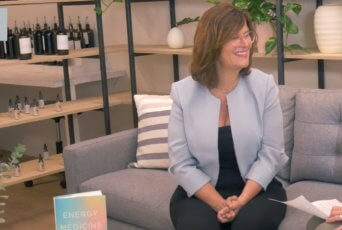There are all sorts of potential ways to deal with anxiety: meditation, medication, deep breaths, therapy. But there’s one remedy that isn’t talked about very much, despite research showing that it works: tapping. No, we’re not talking about the style of dance where you put on metal-soled shoes and jauntily shuffle across a stage—we’re talking about a type of therapy that uses acupressure to alleviate anxiety, as well as many other mental and physical issues. To learn more about tapping, we sat down with Jessica Ortner, co-founder of The Tapping Solution app. Read on to learn how she discovered tapping, its research-backed benefits, why using tapping for anxiety is so effective, how to tap, and more.
*This is a brief clip of our interview with Jessica Ortner. Click here to watch the whole thing.*
You can also listen to an audio version of our interview with Jessica Ortner on The WellBe Podcast.
Jessica’s Story: Discovering Tapping in a Moment of Crisis
When Jessica was 21 years old, she came down with a cold that she couldn’t beat. She’d been sick for two weeks and was desperate to get better, so when her brother Nick suggested she try out a stress relief technique he’d read about, she was game.
He instructed her to tap on certain points on her head and face, all while talking about her physical symptoms. Jessica was skeptical at first, especially since her older brother was known to play pranks — there was definitely a moment while she was tapping the top of her head that she wondered if he was just trying to see how ridiculous he could make her look.
But it wasn’t a prank. As she tapped and spoke about her symptoms, she felt her body begin to relax. And then, she says, “it was as if the weight is lifted off of my chest, and I gain this new awareness, and I look at him and start crying, and I tell him, ‘I don’t want to get better.’” At the time, she was in a place in her life where she was working extremely hard, but didn’t feel like anything was going her way. The cold she couldn’t beat meant she could stay home and hide from her reality.
Jessica continued tapping, but instead of talking about her physical symptoms, she began talking about her emotions. She described feelings that she didn’t even know she had, feelings she’d pushed aside and distracted herself from by staying busy. “Suddenly, I was giving a voice to these feelings and this anger that I had as I’m tapping on these points, and I noticed again, I was able to relax,” she remembers. “I took this deep breath in and my sinuses had cleared up and my whole body felt energized and I thought, ‘Wow.’”
Despite this transformative moment, Jessica quickly forgot about tapping when life got busy. But then, a few months later, a difficult breakup prompted her to pull out the technique that had been so helpful before. She couldn’t remember exactly where she was supposed to tap, but she did the best she could, and it worked. Again, she felt profound relief. She realized that if she wasn’t even doing it perfectly and was still seeing these results, there must be something powerful there.
In fact, she was so interested in and impressed by the power of tapping that she decided to explore it professionally, and her brothers joined her. They bought camera equipment and created a documentary that showed people’s tapping results from around the world, and then began building their company, The Tapping Solution. From there, they started the Tapping World Summit, wrote several books, and — in what Jessica sees as the culmination of their work — launched The Tapping Solution app.
“All of our work has led us to create an experience where people can easily access tapping,” Jessica says. “Because we’ve had a lot of people say, ‘I read your books. I love it. I did it once. I had amazing results and I never used it again.’ We really want to make tapping the next meditation.”
How (and Why) Tapping for Anxiety Works
So tapping involves tapping your head and talking about your feelings, but what exactly is it? As Jessica explains, “tapping is a stress-relief technique where you stimulate acupressure points
on your body while you think of a stressful thought.” It draws on a combination of ancient Chinese acupressure points — which are the places that you tap — and modern psychology to help alleviate physical and mental anxiety. The acupressure points are the same ones that have been used in acupuncture for thousands of years (and whose effectiveness is backed by much research), but with tapping, you use your fingertips rather than needles.
So here’s how tapping for anxiety works: when we have an anxious thought, we experience that anxiety in our body, whether as stomach pain or chest tightness or an elevated heart rate or something else. Because of that physical anxiety, we can’t just talk ourselves out of an anxious feeling. We’ve already transitioned into fight-or-flight mode, and our adrenaline is up too high to respond to logic or reason. That’s where tapping comes in.
“What you do with tapping is you actually get clear on the thought that’s creating the physical anxiety as you stimulate these points,” Jessica says. “This sends a calming signal to the brain, letting your brain know that it’s safe to relax.” This allows you to think that same negative thought while your body remains relaxed, so your brain is no longer “hijacked by anxiety.” Once you’ve achieved that, you’re capable of taking a step back and dealing with the challenge you’re facing in a resourceful, creative, and rational way.
The Research Behind Tapping for Anxiety and Weight Loss
There’s no question that Jessica has experienced massive benefits from tapping. But what does the research say? In short: quite a lot, and we’re only just getting started.
See, tapping is a relatively new therapy, so there’s not as much research on the topic as there is on, say, acupuncture or meditation. However, in the past ten years, there’s been a significant amount of research into its effectiveness, in particular tapping for anxiety, and, as Jessica says, “I do believe we are just at the forefront.”
She cited two impressive studies that speak to the dramatic effectiveness of tapping. The first, published by the American Psychological Association, looked at tapping for anxiety. In the study, researchers took saliva samples of the subjects to test their levels of cortisol (the so-called “stress hormone”). Then they split the subjects into three groups: one group did tapping, the second read articles about stress relief, and the third just read magazines. After one hour, the researchers measured cortisol levels once more, and found tremendous results. Those in the magazine group had actually become more stressed, with their cortisol levels rising by 2%, while those who read about stress relief had seen a decrease of 19%. But the people who had done tapping for an hour saw their cortisol levels plummet by 43% — that’s right, tapping nearly cut their stress and anxiety in half.
In the second study, which came out of Bond University in Australia, researchers looked into how tapping can be used to reduce cravings and promote weight loss. The study involved 15 obese adults, who were shown photos of foods that people typically crave — chips, cupcakes, and other “junk food” — while an MRI machine scanned their brains. At the start of the study, the scans showed subjects’ brains lighting up in all the areas associated with pleasure and reward, which was particularly striking given that they weren’t even seeing or smelling a real food, just a photo.
Then, they divided the subjects into a tapping group and a non-tapping group. The former tapped for two hours per day for two weeks, while the latter didn’t do anything different. After two weeks, both groups were again shown the same food photos while hooked up to an MRI machine. The control group showed slightly reduced cravings, with a decrease of 5%, while the group that used tapping showed an 18% decrease. At the same time, participants in the tapping group reported that they no longer felt emotionally attached to the foods and had reduced anxiety around the craving.
The Tapping Solution app also offers its own quantitative data into the effectiveness of tapping. Before each tapping session, users rate how anxious they’re feeling on a scale of one to ten, and then rate their anxiety level again once they’ve completed the exercise. For the app’s meditation that uses tapping for anxiety, which has been played over 260,000 times, users see a 41% reduction in anxiety over the course of just nine minutes.
How to Tap
Tapping uses nine specific acupressure points, which have been taught in Traditional Chinese Medicine for thousands of years. There isn’t a consensus on how these points work or why they’re so powerful, but, as Jessica says, “what I do know is that these nine points are so easily accessible and that people are getting incredible emotional shifts.”
So these points are super accessible, but if you don’t know how to tap, that’s not exactly helpful. Luckily, Jessica indulged us in a beginner tapping tutorial! Read on to learn how to tap, or check out the video at the bottom of the page to see a visual.
First off, let’s go over the nine acupoints used in tapping:
- Side of the hand: This point is underneath your pinky, and is also called the “karate chop point.” It doesn’t matter whether you tap on the left side or right side.
- Eyebrow: This point is where the hair of your eyebrow begins, by the bridge of your nose.
- Side of the eye: To find this point, follow your eyebrow until you find yourself on the side of your eye on the bone.
- Under the eye: From your side-of-eye point, follow the bone until you find yourself directly underneath the middle of your eye, about one inch below your pupil.
- Underneath your nose: This point lies directly between the top of your lip and your nose.
- Underneath your mouth: This point can be found in the crease between your lip and chin.
- Collarbone: To find this found, feel the U-shaped bone underneath your throat, then go down an inch and over an inch on either side. There, you’ll feel a point between the bones. If you’re not sure if you’ve found it, Jessica says you can simply tap on your chest with your whole hand to make sure you get the point.
- Underneath the arm: This point is one hand-width from your armpit. For women, this is generally where your bra strap lies.
- The top of the head: This point lies in the center of the top of your head.
So now that you know where to tap, what about how to tap? As Jessica explains, it’s fairly simple, but it’s important to follow a certain sequence.
First, before you begin tapping, rate how you’re feeling on a scale of one to ten. Then introduce an affirmation of acceptance. “So you get clear on the problem and you say, ‘Even though I’m feeling anxious, I accept how I feel,’” says Jessica. She notes that this affirmation is important because we often fight how we’re feeling, so acknowledging and accepting it openly allows us to have a more honest experience with ourselves. Once you’ve settled on an affirmation statement, repeat it three times while tapping on the side of your hand.
Then, as you tap the rest of the nine points, you give voice to how you’re feeling. This can mean repeating the same thing over and over (for example, “I feel anxious. This is anxiety. I feel anxious.”), or telling a story as if you’re talking to a friend. Jessica says that it’s less about the specific words you’re saying and more about getting clear on the thoughts that are creating your physical anxiety.
As you continue to tap, if you start to feel yourself becoming more relaxed, you can begin to introduce positive statements along with the negative ones. “The tapping is sending a calming signal to your body and now your body feels relaxed,” Jessica says. “So now if you have a stressful thought, it’s easier for you to choose a different thought. You’re now in control.” But she emphasizes that it’s important to always begin with the negative, to start with how you actually feel before jumping to how you want to feel.
In terms of how to actually do the tapping, it’s a gentle motion with two or three fingers. You want to feel pressure, but don’t tap so hard that you push your head back or feel any discomfort.
Once you’re done, take a deep breath, and take a moment to check in with yourself. Rate how you’re feeling again, and notice in what ways you feel different than when you began.
Tapping Takeaways and Quick Instructions on How to Tap
Tapping is a huge topic with tons of potential for transforming your mental and physical health. It’s a lot to remember, so here are our key takeaways from our interview with Jessica Ortner:
- Tapping is a type of therapy that uses acupressure points to help people reduce anxiety.
- It combines ancient acupoints from Traditional Chinese Medicine with modern psychology to combat both physical and mental anxiety.
- Research has shown that tapping has been effective in reducing levels of cortisol (the stress hormone) and in reducing food cravings.
- Though there is overwhelming research and anecdotal evidence of the effectiveness of tapping, it’s not known why it is effective (as is the same with acupuncture).
- Tapping relies on 9 acupoints on your body: the side of the hand, the eyebrow, the side of the eye, underneath the eye, under the nose, under the mouth, the collarbone, underneath the arm, and the top of the head.
And if you want to know how to tap yourself, first of all check out The Tapping Solution app! But also, here’s a step-by-step breakdown:
- First, check in with yourself and rate how you feel on a scale of one to ten.
- State an affirmation of acceptance of how you are feeling, and repeat it three times.
- Talk through your feelings while tapping on the nine acupoints.
- Tap gently, using two to three fingers.
- Always begin by voicing negative feelings. If, during your tapping session, you feel yourself shift into a positive, relaxed mindset, you can begin to introduce positive statements.
- After you’re done tapping, take a deep breath and a moment to check in with yourself.
- Once more, rate how you feel on a scale of one to ten.
Watch our whole interview with Jessica Ortner to learn the theories behind why tapping works, how Emotional Freedom Technique (EFT) relates to and differs from tapping, why tapping might be a powerful tool in combating the opioid crisis, how simply getting a diagnosis can create symptoms in people that weren’t there before, and much more. Plus, you’ll be led through an anxiety-reducing tapping meditation by Jessica!
You can also listen to an audio version of our interview with Jessica Ortner on The WellBe Podcast.
Have you ever tried tapping? What was your experience? Tell us in the comments below!
Citations:
The recovery story above is anecdotal and specific to this particular individual. Please note that this is not medical advice, and that not all treatments and approaches mentioned will work for everyone.






COMMENTS